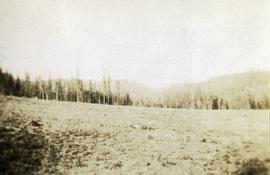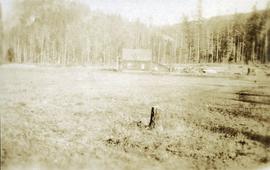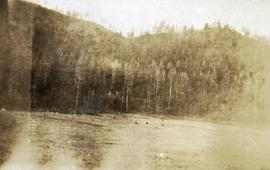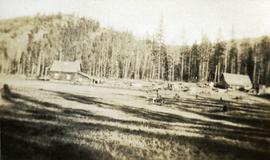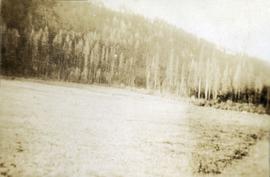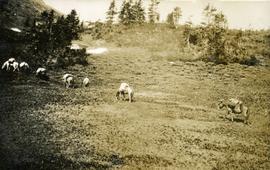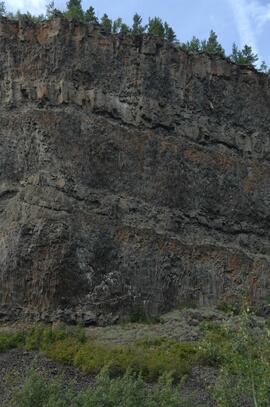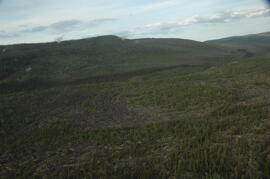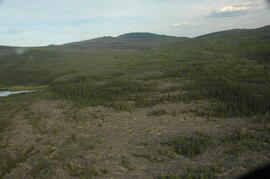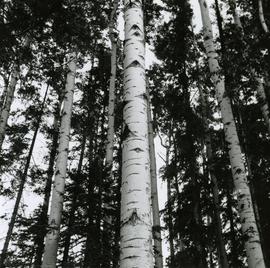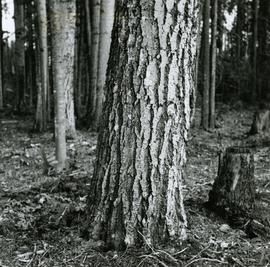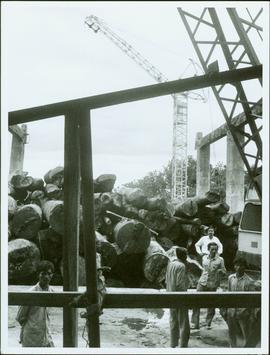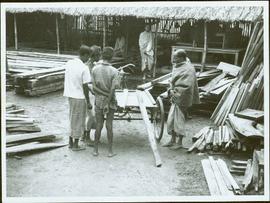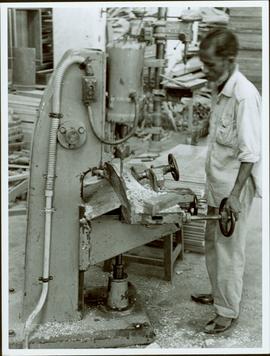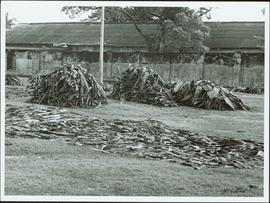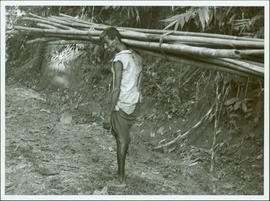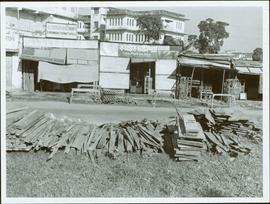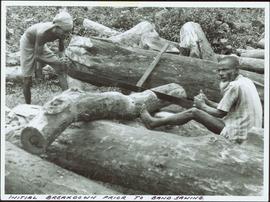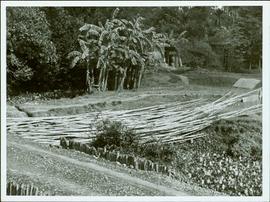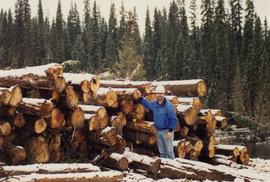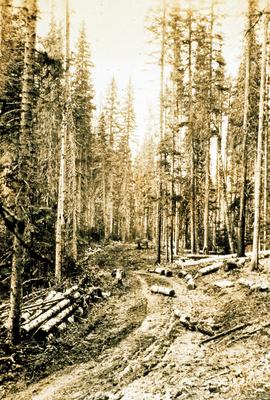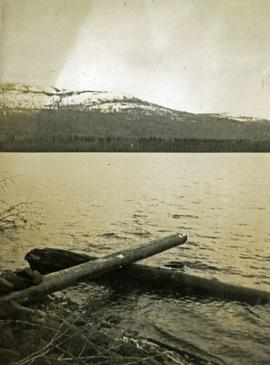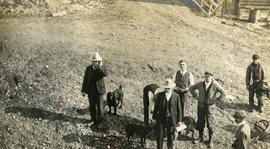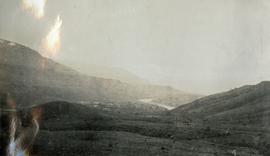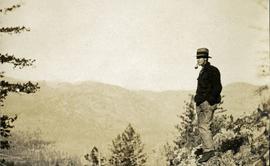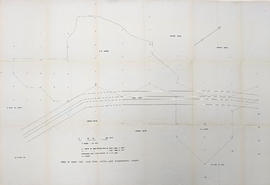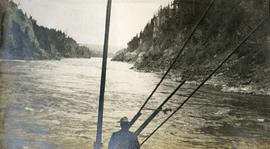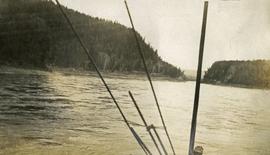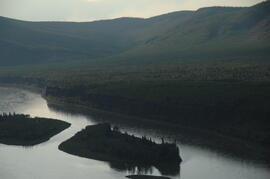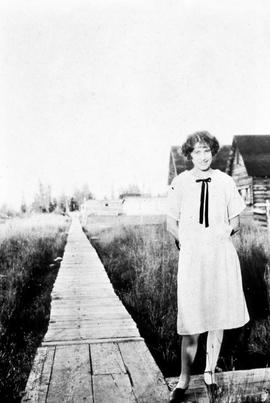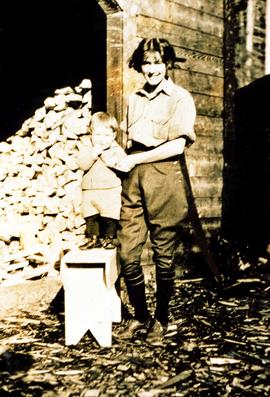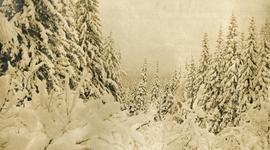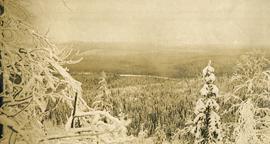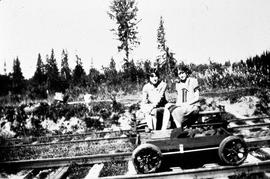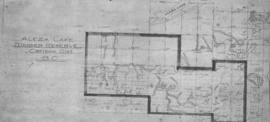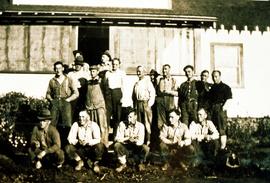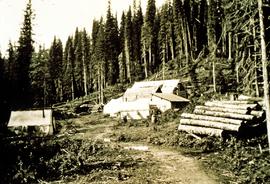Photograph depicts a newly cleared field, forest and mountains in the background.
Photograph depicts a stump in the foreground, a building in the midground and forested mountains in the background.
Photograph depicts a field in the foreground, forest and mountains in the background.
Photograph depicts a field in the foreground, buildings and stumps in the midground and forest in the background.
Photograph depicts a newly cleared field, forest and mountains in the background.
Photograph depicts packed horses walking in single file across an alpine meadow.
Caption describing photograph: "Bark habit at mid-bole."
Caption describing photograph: "Bark habit at base of tree."
Item is a photograph of a stack of logs with a crane in the background.
Item is a photograph of men talking in a lumber yard.
Item is a photograph of a man operating a piece of wood cutting machinery.
Item is a photograph of piles of bark in a field.
Item is a photograph of a man carrying bamboo poles.
Item is a photograph of lumber piled along a commercial street.
Item is a photograph of two men swede sawing a log.
Item is a photograph of a pile of bamboo in a field.
Photograph depicts a Balsam timber pile adjacent to Aleza Lake Research Forest sign on the Giscome highway. Mark Clark is pictured.
Photograph depicts a Balsam timber pile adjacent to Aleza Lake Research Forest sign on the Giscome highway. Mark Clark is pictured.
Item is a photograph of a copy print that has been reproduced as a slide, resulting in low photographic quality. Location of original photograph unknown.
Frank Dickson was a UBC pathologist who studied heart rot in balsam at Aleza Lake Experimental Station (and also gave great haircuts).
Photograph depicts a view from the shore of Babine Lake looking across the water to forest and snowy mountain peaks in the distance. [55th parallel]
Photograph depicts a group of men and dogs standing outdoors in the sunshine.
Item is an original "Atlin Park Lake Trip Report" by W.G. Hazelwood. Includes original photographic prints pasted into the report.
Photograph depicts rolling hills with dry vegetation and river in the background.
Photograph depicts A. H. Holland viewing North Fork valley from a high mountain ridge.
Photograph depicts twenty-eight or more people standing on the river's edge, a stack of wood is ready for loading on the steamer that is anchored near the shore.
Technical drawing reflects depth of sand established as more and less than 6 feet.
Photograph depicts a view of the river shore, a few scattered buildings and tents are near the shore. A footpath leads from the water's edge between the dwellings and through the newly cleared land.
Photograph depicts view from the steamboat deck approaching Cottonwood Canyon.
Photograph depicts a view from the steamboat deck approaching Cottonwood Canyon.
Unpublished results for the Sulphur stable isotope tracer study (E.P. 886.15) were presented in annual reports to the funding agencies, including this FII Final Report from April 2003.
Item is a photograph of a copy print that has been reproduced as a slide, resulting in low photographic quality. Location of original photograph unknown.
"Ray Sansom, an assistant ranger at Aleza Lake, was hired as station foreman by the Research Division. He and his family moved into the log cabin at A.L.E.S." --from the notes of Ralph Schmidt in accompanying file
Item is a photograph of a copy print that has been reproduced as a slide, resulting in low photographic quality. Location of original photograph unknown.
"Ray Sansom, an assistant ranger at Aleza Lake, was hired as station foreman by the Research Division. He and his family moved into the log cabin at A.L.E.S." --from the notes of Ralph Schmidt in accompanying file
Item is "An Analysis of the Difference in Gross Merchantable Cubic-foot Volumes of the Upper Fraser Uneven-aged Spruce-Balsam Type When Computed by 2-, 4-, 6-, and 8-inch D.B.H. Classes" from the BC Forest Service "Research Notes" series.
This PDF contains site location data, annotated soil profile photographs, and AMS radiocarbon dates for 2008 soil charcoal samples collected at Kluane Lake, Yukon Territory.
This PDF contains site location data, annotated soil profile photographs, and AMS radiocarbon dates for 2004 soil charcoal samples collected at Kluane Lake, Yukon Territory.
Photograph depicts snow covered trees and forest.
Photograph depicts snow covered trees and forest.
Item is a photograph of a copy print that has been reproduced as a slide, resulting in low photographic quality. Location of original photograph unknown.
"After we made the acquaintance of several girls living in Aleza Lake village, they would be invited to come to the camp on a Sunday to enjoy the music. Social events were infrequent, so they did not complain about having to travel three miles by rail and then walking another three-quarters of a mile on a foot trail that was sometimes quite muddy." -- quote from Cedric Walker in "An Early History of the Research Branch, British Columbia Ministry of Forests and Range" (p. 48)
Reproduced map on mylar depicts the Aleza Lake timber reserve near Aleza Lake, BC.
Item is a 3.5" floppy labelled "Aleza Lake Stem Map Data – AutoCAD Release 14 – Northline 1998". Floppy contains the following file: mofcopy.dwg.
Item is a photograph of a copy print that has been reproduced as a slide, resulting in low photographic quality. Location of original photograph unknown.
Item is a photograph of a copy print that has been reproduced as a slide, resulting in low photographic quality. Location of original photograph unknown.
Item is a forest cover map for Aleza Lake Research Forest (Special Use Permit 19070). Shows experimental plots and timber sale areas.
